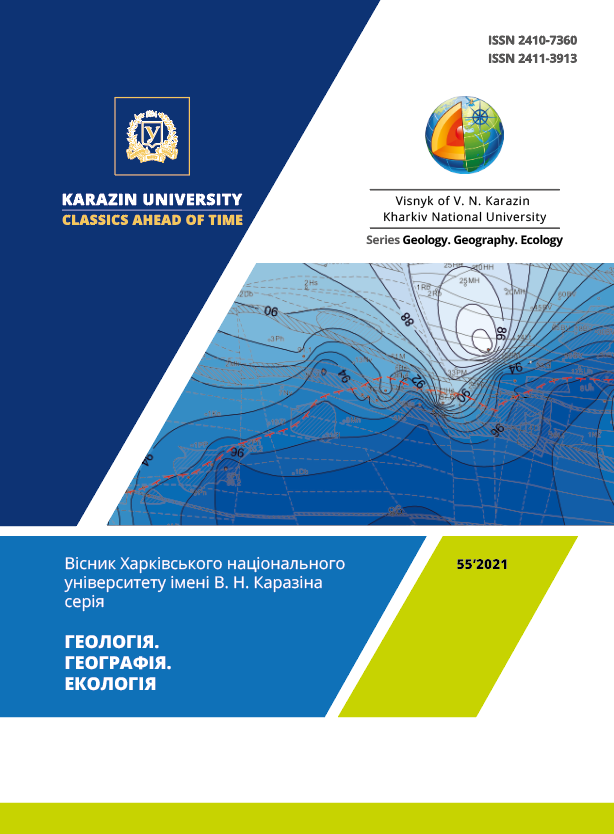Influence of the structure of a mineral adsorbent on the detritization of aqueous solutions
Abstract
Introduction. Formed in a nuclear reactor, tritium is mainly discharged into the hydrosphere. A significant part of tritium also enters the environment during the reprocessing of spent nuclear fuel. Currently, the problem is the development of effective, simple, affordable, inexpensive and low-energy methods for extracting tritium from large volumes of low- and intermediate-level aqueous solutions.
Review of previous publications. At nuclear power plants, it is widely used for the purification of small volumes of highly active process waters by isotopic exchange in the "hydrogen-water" system [patents RU 2380144, RU 2060801, RU 2525423, RU 2148426]. There are methods for isotopic fractionation of НTO by low-temperature rectification, which either requires significant energy consumption or occurs with a very insignificant isotopic effect at the level of 1.1 [patents UA 57558, RU 2010772, RU 2091336]. In world practice, mineral adsorbents are widely used, but there are no developments designed to purify aqueous solutions from tritium. Our previous studies have clarified the possibility of using layered silicates and zeolite for the extraction of tritium from aqueous solutions (patents UA 103033, UA 103050, UA 113348). The ability of other minerals to adsorb tritium from aqueous solutions remains unresolved. In order to solve this problem, we involved in experimental research minerals from the classes of hydroxides, sulfates and chain silicates.
Purpose. The aim of the work is to determine the influence of the structural features of mineral adsorbents on the removal of tritium from proto-tritium water ("НTO") and the possibility of using a more expanded spectrum of minerals as such adsorbents.
Results. Up to 39% of tritium extracted from tritiated water is retained in hibsite in surface adsorbed form. In the boundary layer, heavier НTO molecules are retained with a greater advantage than H2O molecules (α = 1.14). Gypsum: due to the substitution of OH groups of the gypsum crystal lattice by OT groups in the mineral structure, up to 36% of the absorbed tritium solution with partial isotope-hydrogen fractionation is fixed. Due to the presence of tangled fibrous microtexture in wollastonite, a significant part of tritium absorbed during the experiment from a solution of tritiated water is fixed in a surface adsorbed form (61.3%, fractionation coefficient α = 1.03). The reaction of hydroxylation of CaO when it interacts with tritiated water is accompanied by a predominant binding to calcium of OT groups formed by the dissociation of НTO molecules because heavy hydrogen isotopes form a stronger covalent bond with oxygen than with protium (α = 1.23).
Conclusions. The highest total ability to extract tritium from aqueous solution was observed in hibsite (38.7%), and the lowest - in wollastonite (34.5%). The obtained new scientific results with the involvement of the results of our previous studies provide an opportunity for more effective development of methods for detritalization of aqueous so-lutions.
Downloads
References
Bell R. (1977). Proton in chemistry. Moscow: Mir, 384. [in Russian]
Deer W.A., Zusman J., Howie R.A. (1965). Rock-forming minerals. Moscow: Mir, 3. Sheet silicates. 318. [in Rus-sian]
Deer W.A., Zusman J., Howie R.A. (1965). Rock-forming minerals. Mir, Moscow, 5, Nesilikatnye minera., 404. [in Russian]
Kuzmenkov MI, Khotyanovich OE (2008). Chemical technology of binders. Available at: https://studopedia.info/5-77070.html [in Russian]
Nesmeyanov A.N. (1972). Radiochemistry. Moscow: Chemistry, 591. [in Russian]
Pushkarov, O.V., Rudenko, I.M, Skrypkin, V. V. (2016). Adsorption of trit-ium from aqueous solutions of treated clay minerals. Visnyk of Taras Shevchenko National University of Kyiv. Geology, 71, 43-48. https://doi.org/10.17721/1728-2713.71.07 [in Russian]
Pushkar'ov, O.V., Rudenko, I.M., Dolin, V.V. (Jr.), Pryjmachenko, V.M. (2014). Sepiolite-zeolite composites as a potential reactivity waterproof barri-ers. Collected scientific papers of Institute of environmental geochemistry, 23, 75-84. [in Ukrainian]
Pushkarev V., Rudenko I., Zubko O., Dolin V. (Jr.) (2019). Nitrogen and humic acid activation of alumosilicatesfor improving the adsorption of tritium from water solutions, Visnyk of Taras Shevchenko National University of Kyiv: Geology. 1(84). 16-20. http://doi.org/10.17721/1728-2713.84.02 [in Ukrainian]
Pushkarov, O.V, Rudenko, I.M., Koshelev, M.V., SkripkIn, V.V., DolIn, V.V. (Jr.), Pryimachenko, V.M. (2016). Miner-al adsorbent of tritium based on sap-onite and zeolite. Collected scientific papers of Institute of environmental ge-ochemistry, 25, 38-48. [in Ukrainian]
Pushkrov, O.V., Pryimachenko, V.M. (2010). Interaction between hot and clay minerals. Collected scientific papers of institute of environmental geo-chemistry, 18, 149-158. [in Ukrainian]
Pushkarov, O.V., Pryimachenko, V.M., Zolkin, I.O. (2012). Bentonite-ceolite composites' properties with respect to tritium extraction from tritium water. Collected scientific papers of Institute of environmental geochemistry, 20, 98-108. [in Ukrainian]
Pushkarov, O.V., Lytovchenko A.S, Pushkarova, R.O., Yakovliev, E.O. (2003). The dynamics of the accumulation of tritium in the mineral environ-ment. Mineral resources of Ukraine, 3, 42-45. [in Ukrainian]
Pushkarov O.V., Rudenko, I.M., Rozko A.M., DolIn, V.V. (Jr.) (2018). Influence of the thermal treatment of palygor-skite on the adsorption of tritium from water solutions. 40, 3, 97–104. https://doi.org/10.15407/mineraljournal.40.03.097 [in Ukrainian]
Rabinovich I.B. (1968). Vliyanie izotopii na fiziko-himicheskie svoystva zhidkostey. Moskow: Nauka, 308. [in Rus-sian]
Rudenko, I.M., Pushkarov, O.V., Dolin, V.V. (Jr.), Zubko, O.V., Grechanovskaya E.E. (2017). Tritium indicator of effectiveness of thermomodification of adsorption properties of clinoptilolite. Miner. J., 39 (2), 64–74. https://doi.org/10.15407/mineraljournal.39.02.064 [in Ukrainian]
Rudenko, I.M. (2017). Fractionation of heavy hydrogen isotopes in the "mineral – water" system. PhD thesis. Kyiv. [in Ukrainian]
Evans E. (1970). Tritium and its compounds. Moscow: Atomizdat. 312. [in Russian]
Brindley G. W. and Nakahira M. (1959). X-ray diffraction and gravimetric study of the dehydration reactions of gibbsite. Zeitschrift fur Kristallographie, Bd. 112. 136-149. https://doi.org/10.1524/zkri.1959.112.jg.136
Hare C. H. (1998). Mechanisms of Corrosion Protection with Surface Treated Wollastonite Pigments. The Journal of Protective Coatings. 14. 47-82.
Safety data for wollastonite. Available at: https://web.archive.org/web/20070815213541/http://physchem.ox.ac.uk/MSDS/WO/wollastonite.html
Wypych Fernando (2009). VII - caulinita e haloisita. Available at: https://www.researchgate.net/figure/Figura-4-Figura-4-Estrutura-do-tipo-brucita-A-e-do-tipo-gibbsita-B-com-vista_fig2_292726910





